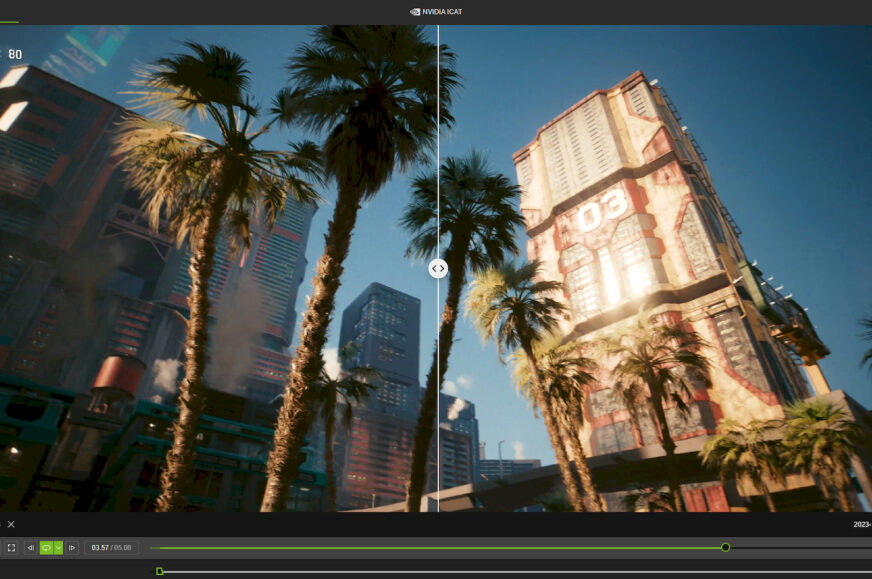Conclusion
In this article, we’ll take a look at some of the exclusive technologies that Nvidia GeForce RTX 4000 generation graphics cards can provide. We are going to explain the most significant new features currently supported by the GeForce graphics card ecosystem and perform tests showing how they affect performance in Cyberpunk 2077 with the new Phantom Liberty expansion. And we’ll also take a look at what they’re doing to image quality.
Conclusion
Ray Reconstruction really works
The pleasant finding is that Ray Reconstruction actually has no negative effect on performance and, on the contrary, helps it a bit due to the simplification of the rendering process. The performance increase with Ray Reconstruction is practically always there, but surprisingly it is higher with the GeForce RTX 4060 (typically 5–8%), whereas with the more powerful GeForce RTX 4090 you only gain more like 1–2% of performance.
For some reason, though, we find that on the GeForce RTX 4090, you’ll only see these FPS improvements with Frame Generation enabled – without this workaround, the high end card doesn’t see any improvement in average FPS in 1080p and 1440p in Overdrive Mode. But it did increase minimum FPS, which can also be counted as an improvement. However, at 4K resolution, when the performance requirement is the highest, FPS start to improve as well and Ray Reconstruction is already having a higher benefit (4–9% FPS improvement) in general even on the RTX 4090.
Almost always it’s a single-digit percentage improvement in performance, but that doesn’t make it insignificant as it’s also a feature that’s supposed to improve image quality. According to these results, it’s thus – at least in Cyberpunk 2077 Phantom Liberty – always beneficial.
Visual bonus
The visual side of Ray Reconstruction also held up. We did notice some places where it looked like there was regression along with improvements elsewhere (that reflection in the puddle), but in other cases Ray Reconstruction leads to better detail in low contrast parts of the scene (in the shadows). The fact that there is not an improvement everywhere with this change of the de-noising filter is something that can happen with denoisng filters. The positives hopefully outweigh this, and to the feature’s credit, it does improve performance a little.
It’s hard to judge how much of a benefit the visual improvements are, which is also true for Overdrive Mode/Path Tracing. In terms of ease/comfort and enjoyment of gameplay, you probably won’t get much out of these changes, but that’s often true of graphical embellishments. For example, we’re not sure about the benefit in the daylight scenes (although the third scene, if not in the second, hints there can still be a benefit in the realism of the shadows).
Overdrive Mode has it tough in that its impact on performance is brutal, while perhaps not being quite as much of a leap as the first partial implementation of ray tracing was. Or at least not always (those daytime scenes, again). I guess you can’t say that these two features are as they say “must have”, but they sure are “nice to have”. So a nice bonus, though not something you can’t survive without.
Frame Generation: Overdrive becomes playable for GeForce RTX 4090
While the generation of extra frames is expected to be a great asset for the final FPS, it is important to remember that these are not full-value frames, but only interpolated “filler” ones, as these frames do not directly reflect the game physics or action (and there is the potential for them having lower quality). Looking purely at the end FPS values achieved, even in Overdrive Mode on the GeForce RTX 4090 this tool manages to achieve roughly double the final frame rate, which roughly corresponds to the principle of generating new intermediate frames at a 1:1 ratio to the frames actually rendered by the game.
However, we see that 4K resolution in Overdrive Mode already deviates from this result and the GeForce RTX 4090 shows a performance (final FPS) increase of only 65–73% with Frame Generation. This may indicate that even this GPU is already over-taxed, and even the Optical Flow calculations and frame generation itself have such an overhead that it reduces the number of real rendered frames per second that the GPU can handle. Thus, after that doubling, the final result is no longer “2×”.
Even at 1080p, the GeForce RTX 4060 is at best barely making it
This hypothesis is supported by the fact that the overall weaker GeForce RTX 4060 graphics card also fails to double FPS in Overdrive Mode. The final FPS improvement for this card is only 60–70% at lower resolutions (1080p and 1440p), similar to the RTX 4090’s situation at 4K. And when the RTX 4060 gets tasked with attempting 4K resolution in Overdrive Mode, it can already only boost final FPS by 34–37%, indicating that the computational cost of generating frames is already such that it sabotages the underlying real-world FPS in a way that the vast majority of the theoretical 2× benefit is lost.
It has to be said that at these higher resolutions, Overdrive Mode is more or less unplayable overall even with frame generation on the GeForce RTX 4060. Even after frame generation, you only get 20.6 FPS in 4K or 38.7 FPS in 1440p. And it’s worth remembering that low frame rates are where the drawbacks or issues of frame generation will show up the most, so the improvement in smoothness may not be great in practice (even latency degradation grows worse the lower the FPS). In general, it’s more recommended to use frame generation as a bonus only if some semblance of a playable frame rate is already achieved even without it.
Whether Frame Generation canmake Overdrive Mode playable on the GeForce RTX 4060 is something that is mostly only up for discussion at 1080p resolution. There, 36.1 FPS was measured without the feature (we’re counting the result with Ray Reconstruction On here as there’s no reason to have it turned off) and we got 60.9 FPS with the generated frames (which implies that the real game framerate has dropped to 30.5 FPS). Whether this will be enough is quite the question, though; 30 FPS is already quite a low framerate (“cinematic” FPS according to Ubisoft), and it’s questionable whether doubling by interpolations is enough help when we are starting this low. I guess it will depend a lot on the demands and needs of the particular gamer. On the other hand, at least for the purposes of checking out the next-gen graphics, it should be enough.
Yet with the RTX 4090 at 4K resolution, all of these tools will produce a 100 FPS end frame rate that should actually be usable without complains at that point, even if half of them are generated frames. However that’s the way it goes, these days there’s a very large performance chasm between the graphics representing the absolute high end and the lower mainstream models available.
English translation and edit by Jozef Dudáš
The partner of this article is the e-shop Smarty.cz, which sells various PC stuff including graphics cards. Just click here. Many thanks for the cooperation!
- Contents
- Frame Generation. What is it about?
- Nvidia Reflex: Principle of operation
- Ray Reconstruction: The new feature brought by DLSS 3.5
- Testing methodology
- Test results – Ray Tracing: Overdrive Mode
- Test results – Ray Tracing: Ultra
- Comparison of image quality and Nvidia ICAT
- Conclusion











